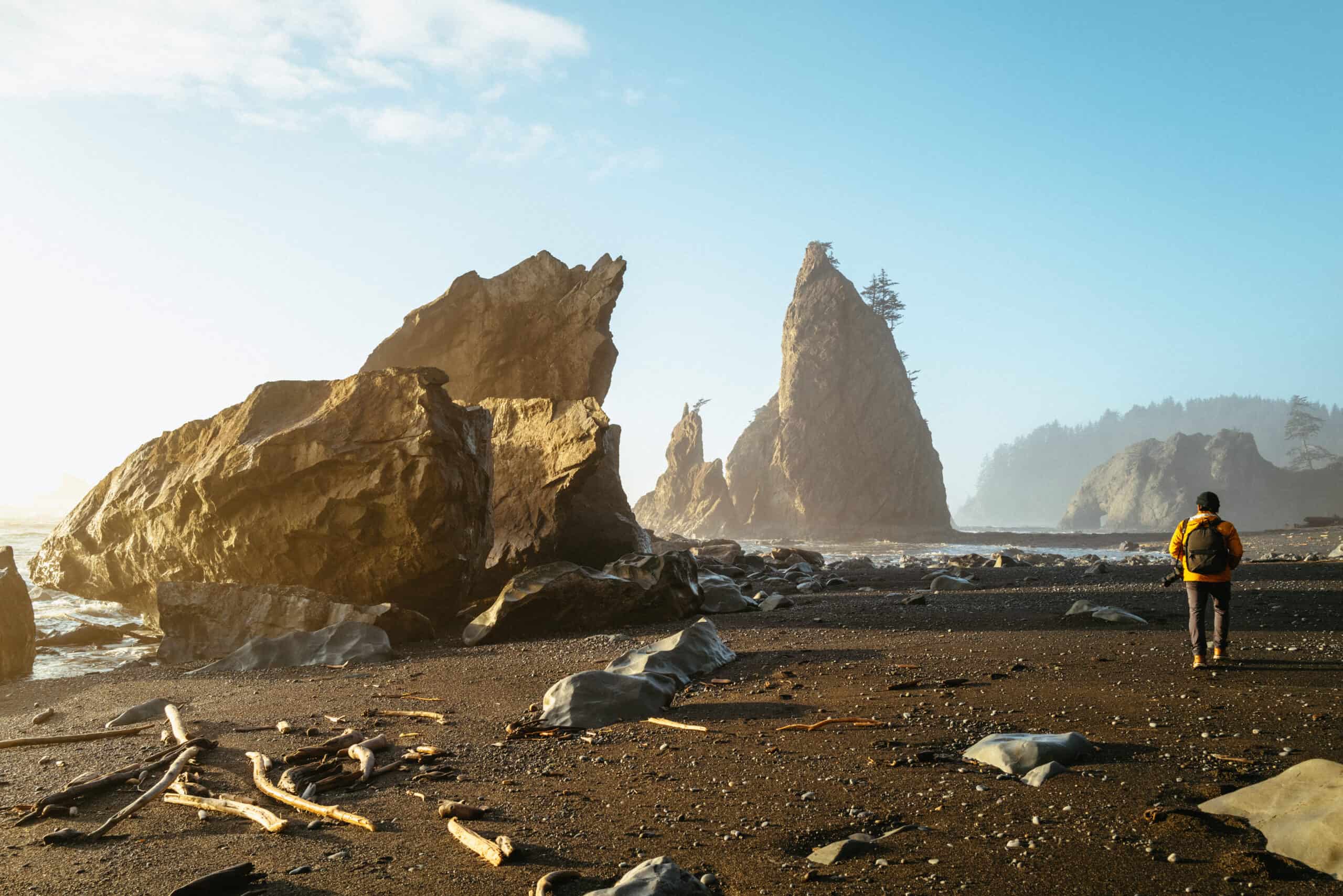Post Summary: Fun Facts About Olympic National Park
Did you know that there are two species of slugs in Olympic National Park? Or that the only Olympic marmots in the world call the Olympic Mountains home?
With the largest population of Roosevelt Elk in the US, tons of unique plants and animals, programs to adopt a fish, and millions of guests each year, there are tons of fun facts about Olympic National Park!
Keep on scrolling to learn more about these fun facts and MORE!
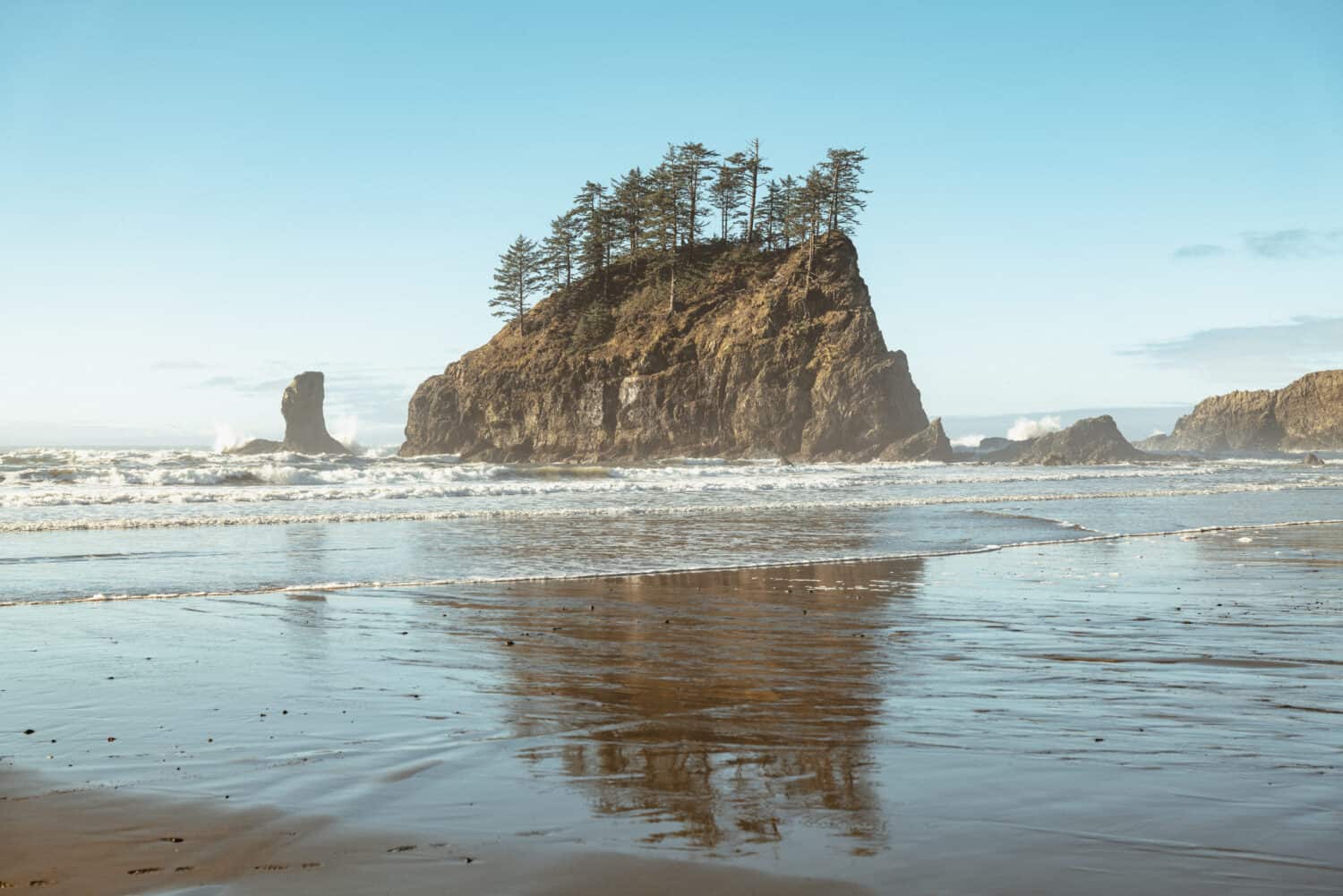
Fast Facts About Olympic National Park
- The park is located on the Olympic Peninsula in Washington State
- Olympic National Park has over 3 million visitors every year
- The park includes 922,650 acres of land
- Mount Olympus stands at 7,980 feet, the highest in the Olympic Mountain Range
- Hurricane Ridge is one of the most popular park destinations
- 95% of the park is designated wilderness area
- There are 60 named glaciers in the park
- There are over 650 archeological sites in Olympic National Park
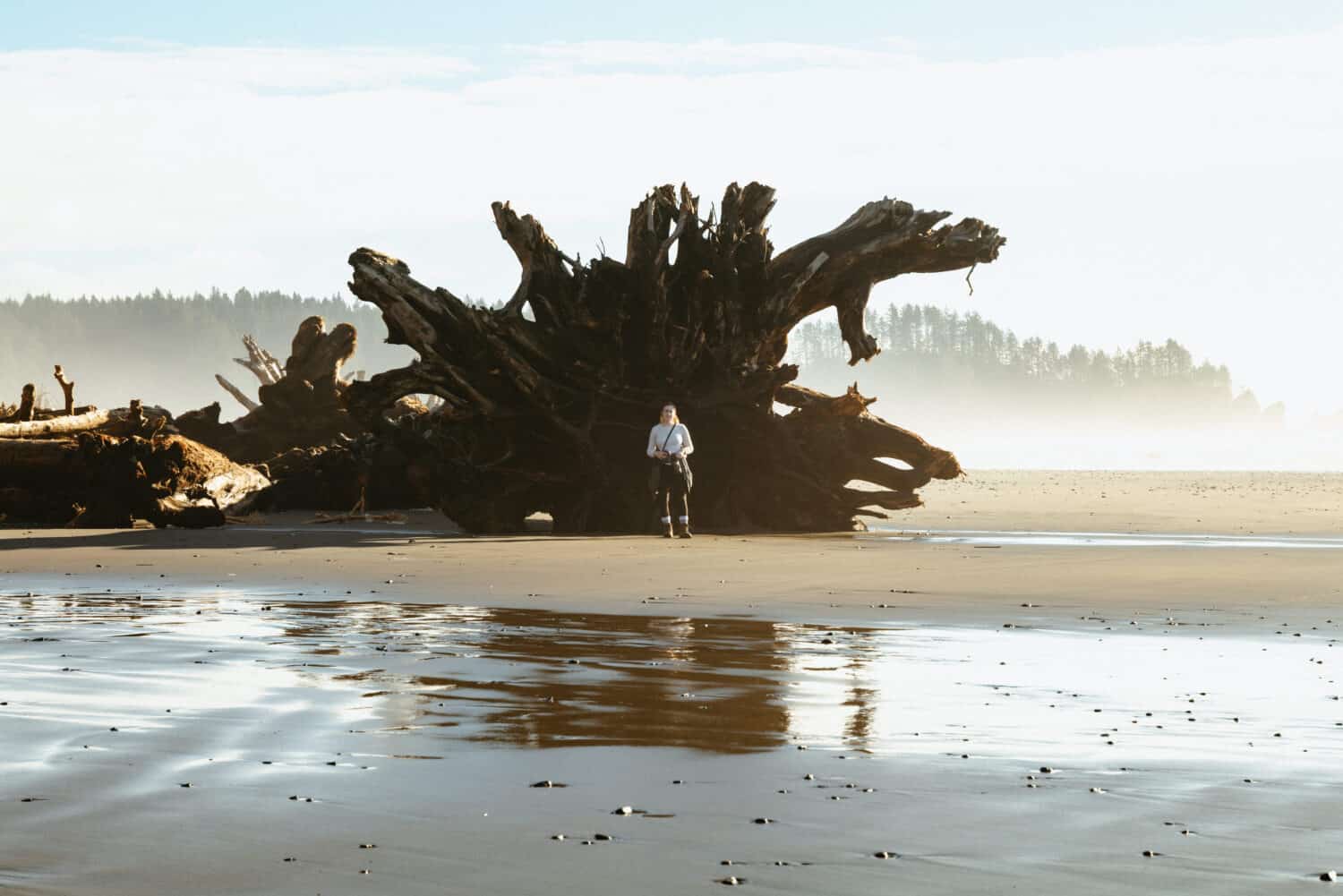
Geology Facts About Olympic National Park
1. Olympic National Park has over 70 miles of coastline.
Some of the best places to enjoy the Olympic National Park coastline are at Ruby Beach, Rialto Beach, Lake Ozette Area, or staying at the Waterfront at Potlatch or Kalaloch Lodge.
From these PNW shores, you can enjoy views of lighthouses, go tide pooling, walk along the rocky beaches, hike, go whale watching, or simply take in the beautiful scenery around you!
2. The Elwha River was once dammed.
The Elwha and Glines Canyon Dams were constructed on the Elwha River to help power local logging and milling operations.
However, this had severe negative effects on the ecosystem, especially on the salmon population in the area.
The largest dam removal in history took place between 2011 and 2014 when both of these dams were torn down to restore the Elwha River ecosystem and salmon runs that once flourished in this area.
3. There are over 3,000 miles of rivers and streams.
Water is one of the biggest defining features of Olympic National Park, whether it’s cloud, glacier, rain, snow, lake, or river.
The most well-known rivers in the park include the Elwha River and Hoh River.
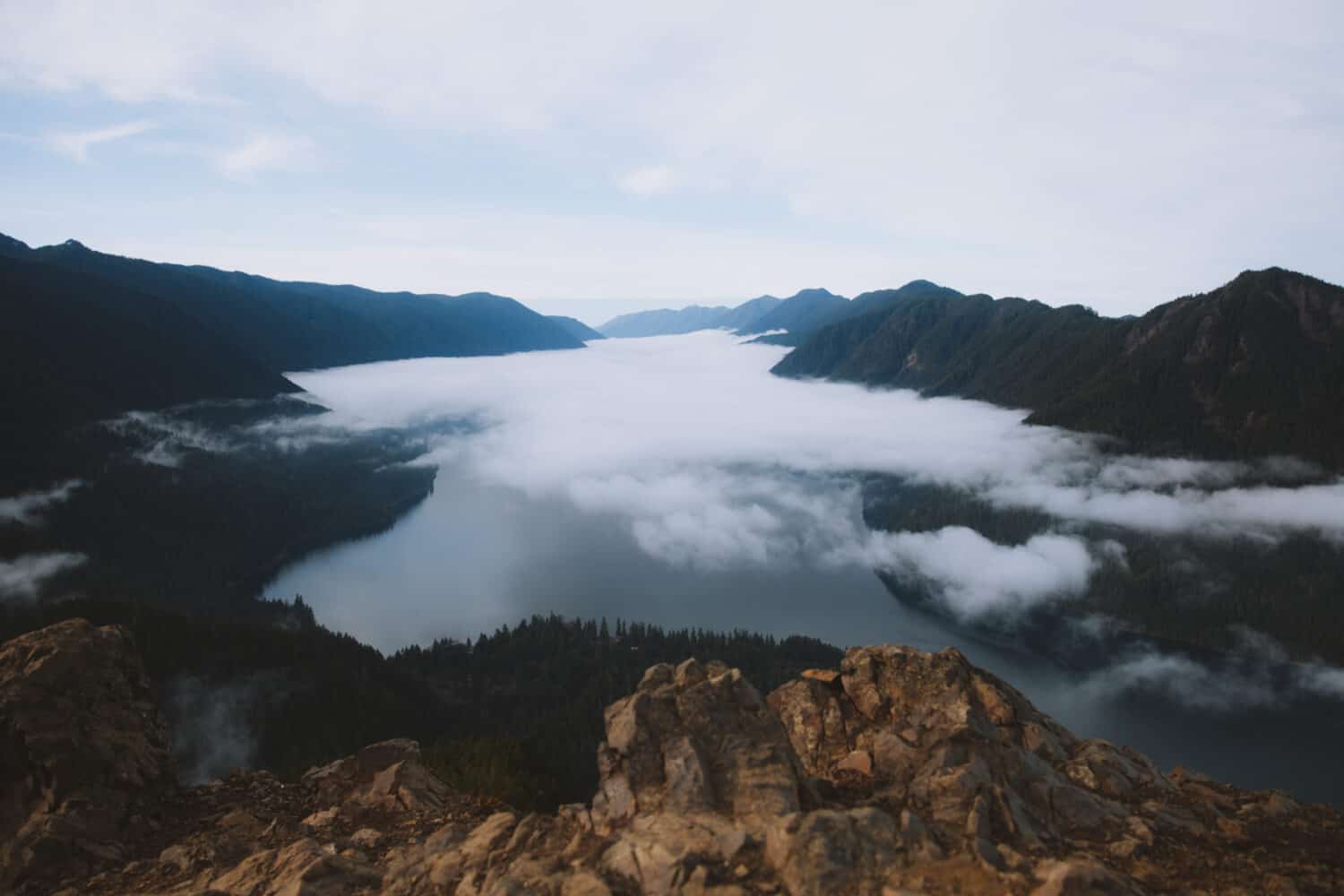
4. You can see over 60 feet down into Lake Crescent – it’s THAT clear!
Located in the foothills of the Olympic Mountains, Lake Crescent is known for its gorgeous blue coloring and crystal clear water.
Canoeing, hiking, picnicking, kayaking, camping (Fairholme Campground), or simply relaxing are all popular activities at Lake Crescent.
5. Hurricane Ridge has a Night Sky Program.
With 95% of Olympic National Park designated as wilderness that has an absence of human-caused light, the park is the perfect place to go stargazing and experience natural darkness!
The Hurricane Ridge Astronomy Program is a great way to learn about astronomy and clearly see the Milky Way.
What makes these fun facts about Olympic National Park so epic is that the Night Sky Program is FREE and perfect for kids!
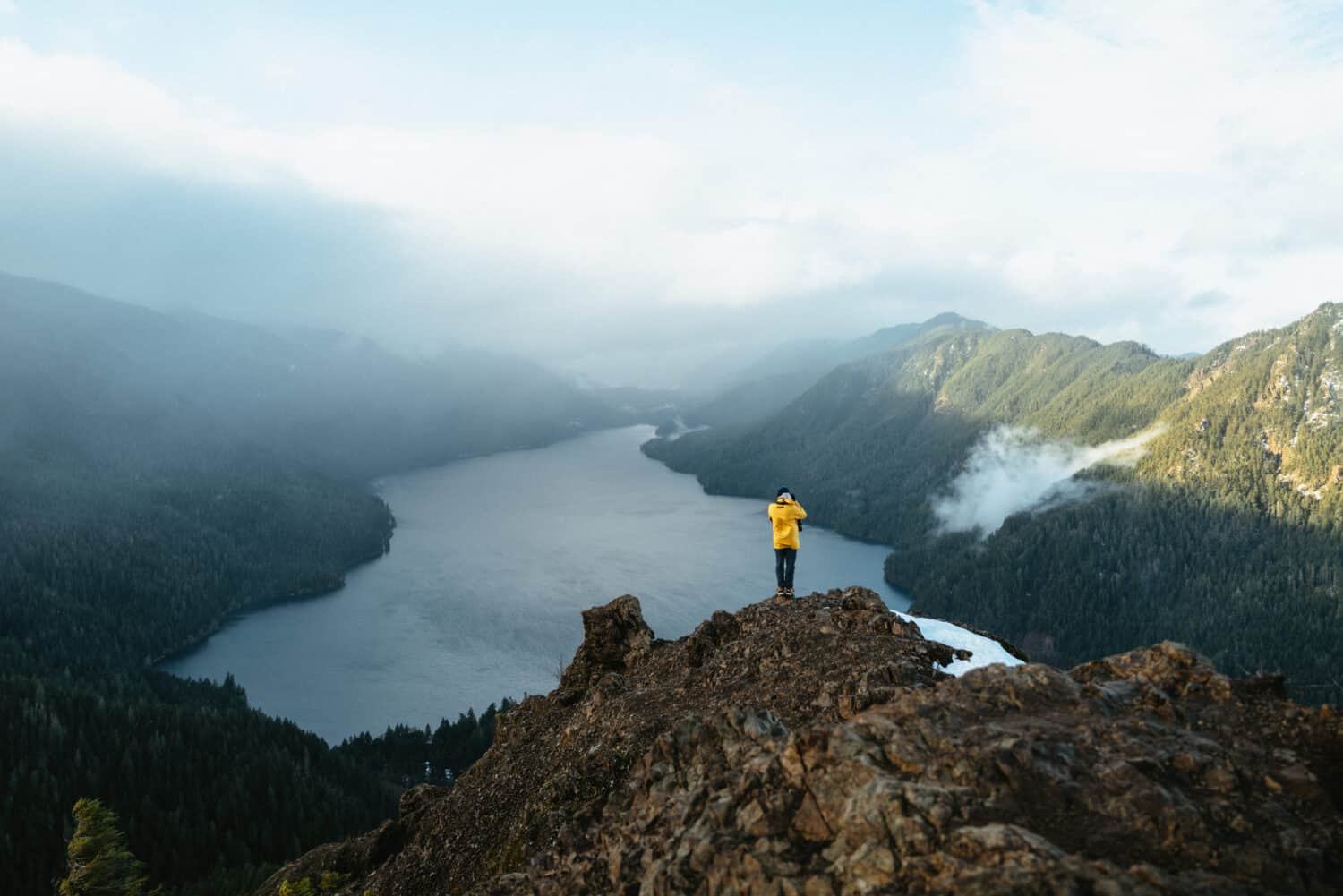
6. Six Different types of environments exist in the park.
One of the coolest Olympic National Park facts is that there are six unique types of environments and landscapes within the borders of the park. That’s a lot for one park (and what makes it so unique)!
These include a coastal forest, lowland forest, temperate rainforest, mountain forest, subalpine forest, and alpine forest!
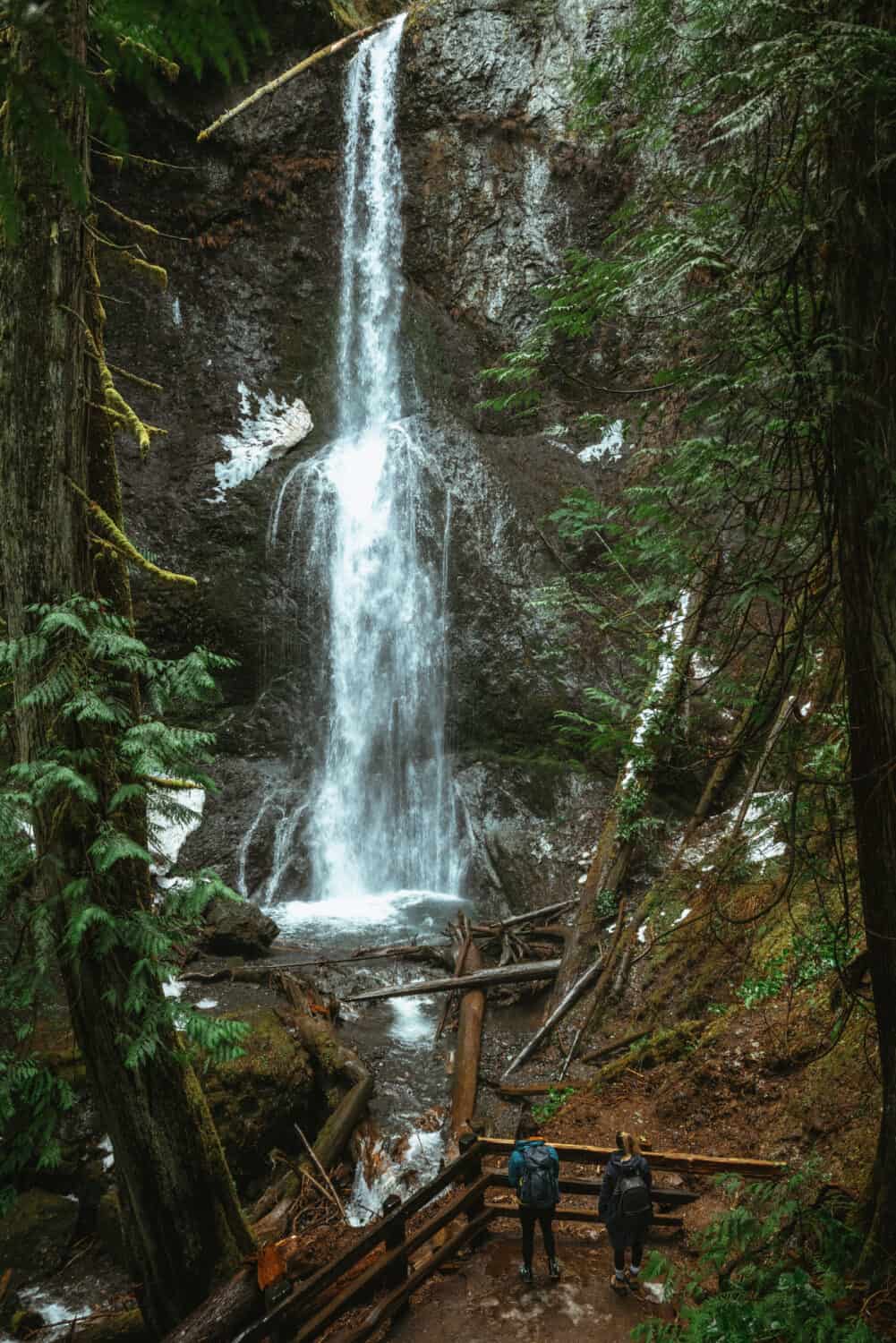
7. The best time to see Olympic National Park waterfalls is April and May.
During the late spring when the snow starts to melt, the waterfalls get full, making it the perfect time to visit Olympic National Park waterfalls.
Sol Duc Falls, Marymere Falls, Madison Falls are the most popular, though there are tons of smaller, or lesser-known waterfalls sprinkled throughout the boundaries of the park.

Facts About The Hoh Rainforest
Looking for more information about what to do here? Read our ultimate guide to the Hoh Rainforest!
8. Olympic National Park has one of the few Temperate Rainforests in the world.
The temperate rainforest in Olympic National Park is known as the Hoh Rainforest and Quinault Rainforest.
Here, you’ll find tons of plants unique to this area, a diverse climate, and classic PNW vibes.
This rainforest is one of the best examples of its kind!
9. There are over 1,200 native Hoh Rainforest plants.
Within the jungle-like Hoh Rainforest, there are over 100 types of moss and 100 year-old trees!
Some of the most common trees you’ll see in Olympic National Park are Sitka spruce, Douglas fir, western hemlock, western redcedar, bigleaf maple, vine maple, red alder, and black cottonwood.
Common shrubs you’ll see are salmonberry and huckleberry (yum!), and you’ll see lots of and epiphytes as well (plants growing on tree trunks and branches).
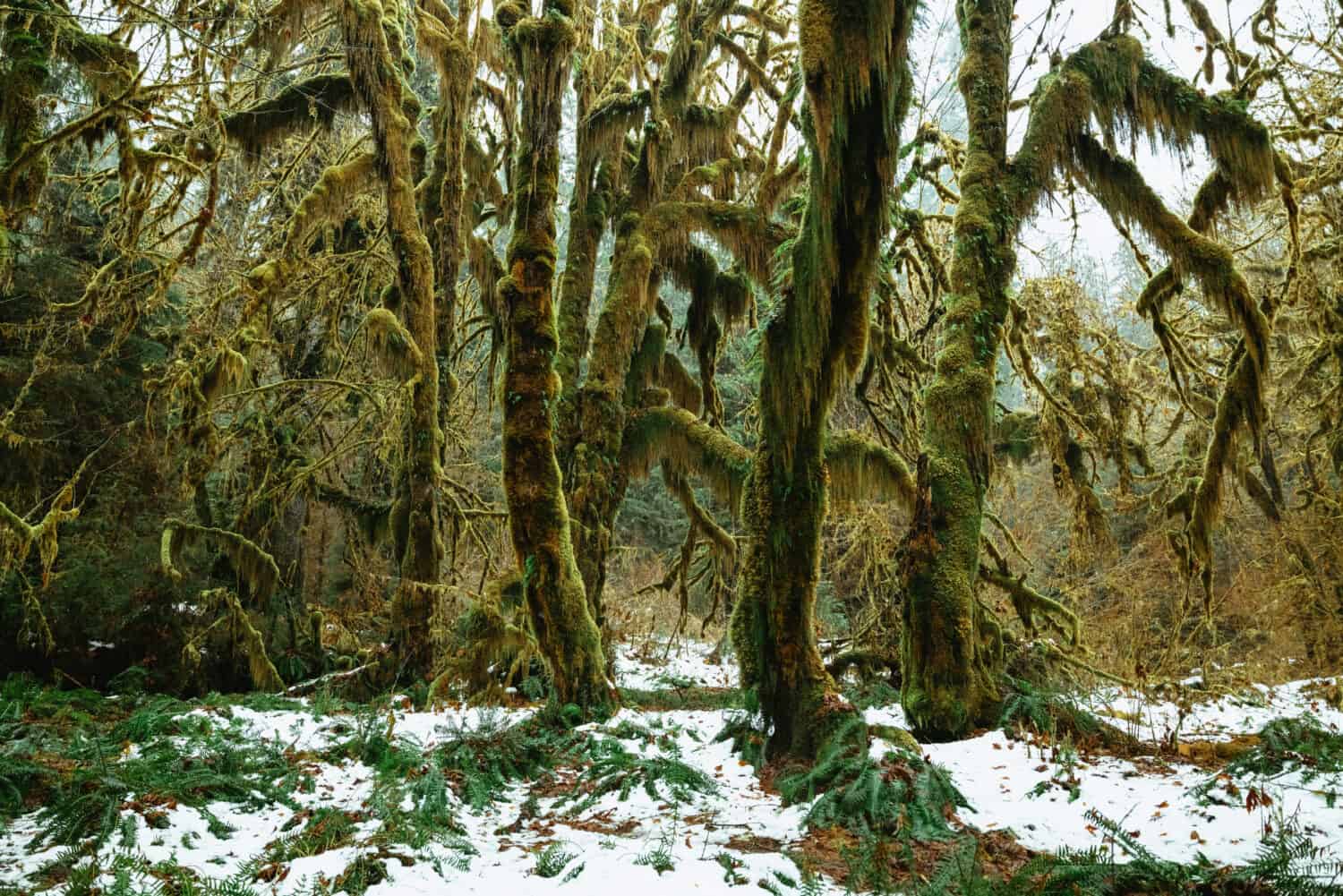
10. The Hoh Rainforest receives over 12 feet of rain per year (3.55 meters).
Because of its location on the Olympic Peninsula and storms off the Pacific Ocean that drop their moisture on the park’s west-facing valleys, the Hoh Rainforest gets TONS of rain.
This means that there are also TONS of plants–especially moss and ferns–that thrive in the diverse, temperate rainforest ecosystem.
So, if you ever find yourself in this neck of the woods, don’t forget to pack a rain jacket and a waterproof pair of hiking boots!!
11. Banana Slugs are vital to the rainforest.
There are two types of slugs that roam the forest floor of Olympic National park: the Banana Slug and the non-native European Slug.
The bright yellow Banana Slug, plays the critical role of helping the ecosystem by consuming fallen debris and vegetation. They’re basically composters for the park!
You can see these 10-inch slugs in the wettest parts of the park, such as the Hoh Rainforest and Quinault Rainforest.
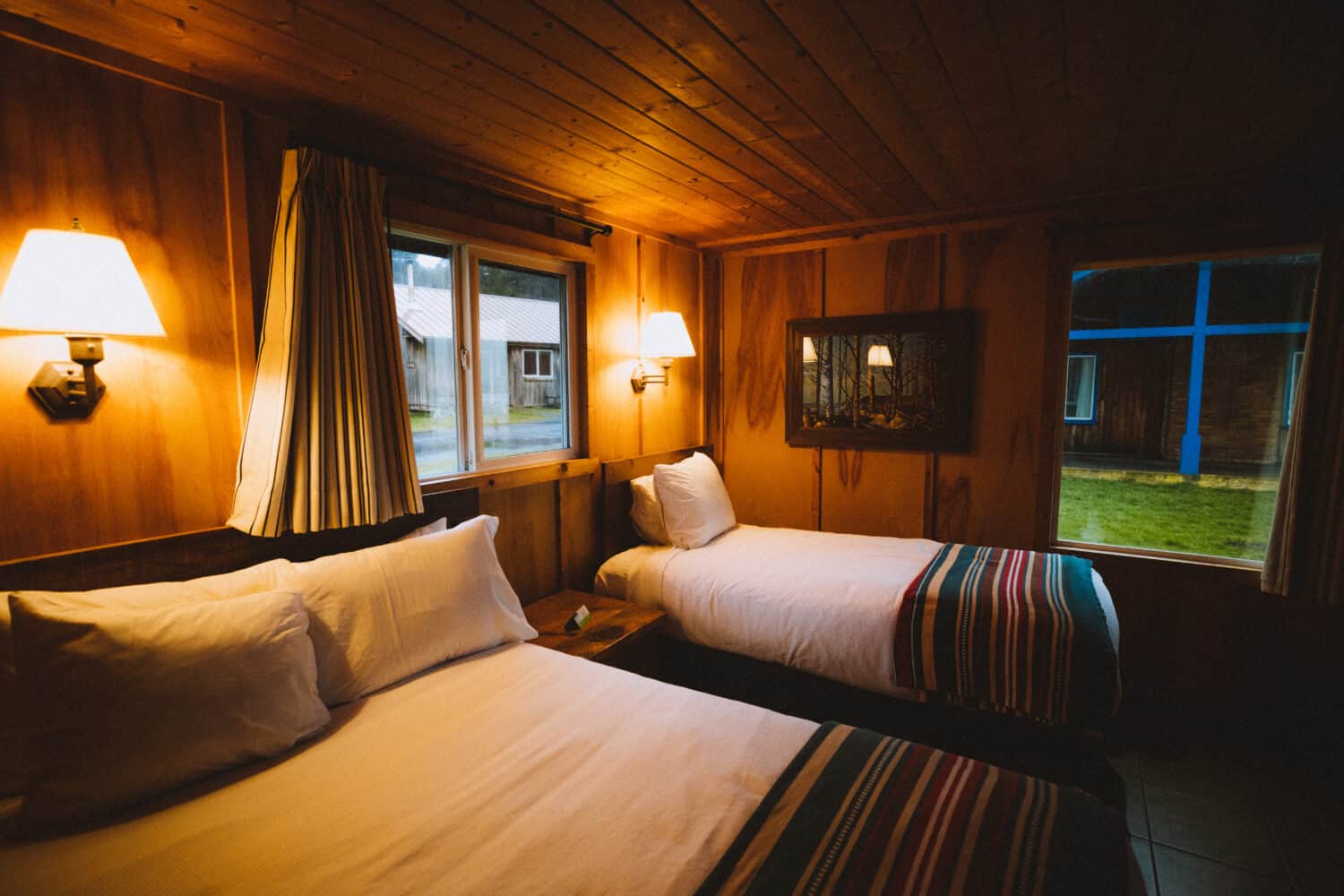
History Facts About Olympic National Park
12. Who Founded Olympic National Park?
Olympic National Park has grown and evolved over the centuries, with different people giving it different names!
The park was originally called the Olympic Forest Reserve, dedicated by President Grover Cleveland in 1897.
After 1907, it became the Olympic National Forest. In 1909 it was renamed Mount Olympic National Monument until finally settling into its current name, Olympic National Park, in 1938.
13. Olympic National Park is rich in history.
Within the park, there is one National Natural Landmark–the Point of Arches.
Currently, there is one archeological site with eligible status to be a National Historic Landmark, which is the Ozette Area.
There are almost half a million museum objects and 130 historic structures in Olympic National Park!
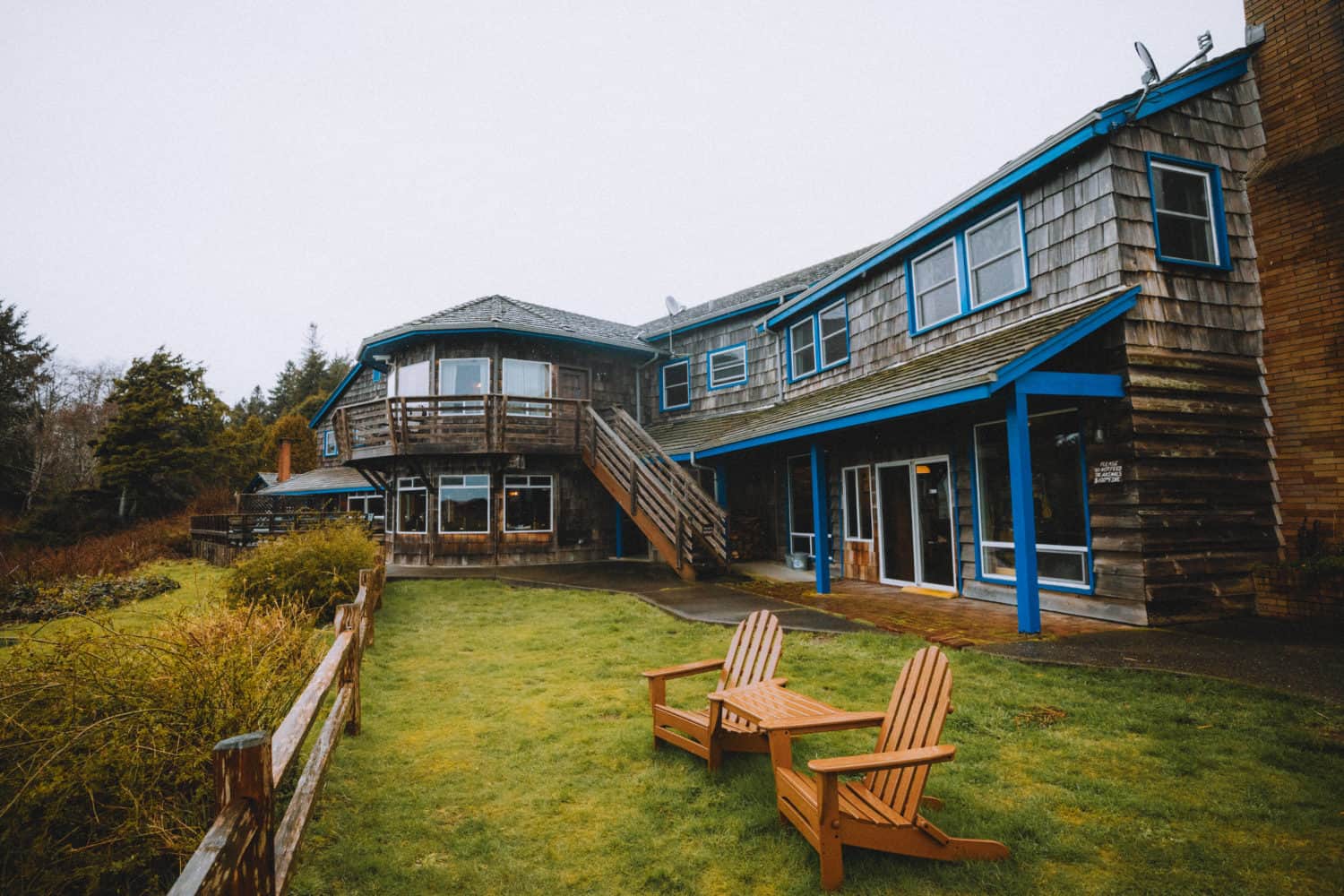
14. The Park has 4 stunning lodges within its borders.
These are Lake Crescent Lodge, Lake Quinault Resort, Sol Duc Hot Springs, Kalaloch Lodge!
Each of these lodges have their own unique history that you can discover for yourself while exploring Olympic National Park.
Read More: The 23 Best Places To Stay Near Olympic National Park
Interesting Facts About Olympic National Park
15. The Roosevelt Elk played a part in the park’s preservation status.
Due to an increase in hunting as more Europeans settled in the area, the resident Olympic National Park Roosevelt Elk were nearly wiped out in the late 1890’s and early 1900’s.
However, when the park changed from a National Monument into a national park in 1938, the Roosevelt Elk and other wildlife were protected, and efforts were put in place to preserve the land.
Nowadays, Olympic National Park is home to the largest populations of Roosevelt Elk in the US!
A great place to see elk is in the Hoh Rainforest, especially on the Spruce Nature Trail.
16. Fires have been important in the development of Olympic National Park.
Olympic National Park has had a long history of wildfires and human-caused fires. Nearly 4,000 acres burned between 2003 and 2010!
The most recent significant fire was the Mt. Dana Fire in 2019. That fire was visible from Hurricane Ridge and Obstruction Point Road within the park, and likely started from lightning strikes in late August. Over the last 40 years, lightning-caused fires account for 43% of ignitions and 63% of total burned acreage!
It’s crucial to track and record these fires, as they can change vegetation patterns, harm old-growth forests, and affect humans in the area. However, they’re also useful tools for understanding the history of the park!
17. You can find petroglyphs on the coastline.
Did you know that Olympic National Park is a World Heritage Site? It is home to artifacts that can date back to 10,000 BCE, including a spear tip found inside a mastodon, petroglyphs, and a partially woven basket,
You can see petroglyphs and carvings of whales, symbols, and hunters by the Makah Tribe for yourself on the Cape Alava Loop (also known as Wedding Rocks via the Ozette Triangle Trail).
Read More: Hike Hole-In-The-Wall Trail at Rialto Beach
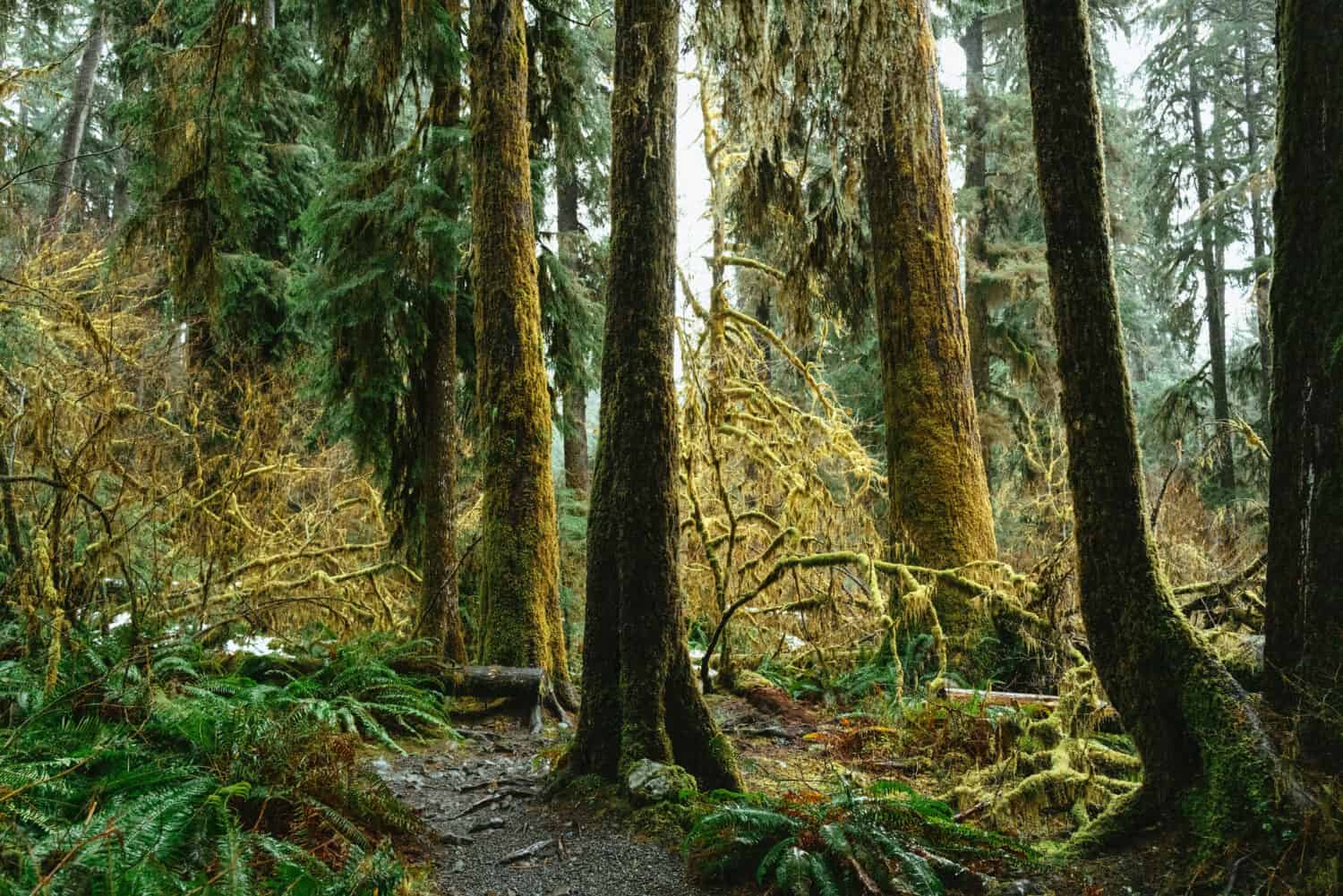
18. How many plants and animals live in the Olympic National Park?
Because of the six unique environments that exist within Olympic National Park, this area is abundant in wildlife!
There are over 20 reptile and amphibian species, over 24 marine mammal species, 300 bird species, and 3 native fish species that live in Olympic National Park.
Unfortunately, 22 of these species are threatened under the Endangered Species Act. Moreover, there are at least 14 kinds of endemic animals and plants in the park.
Because of this, it’s important to protect Olympic National Park’s delicate ecosystem and wildlife. You can do this by leaving no trace, staying on the trail, and avoiding direct interaction with animals.
19. Olympic National Park is home to marmots.
While hiking through Olympic National Park, you might catch a glimpse of a bushy tail skittering by and a creature the size of a typical house cat. This could be one of the park’s many marmots!
One of the most fun facts about Olympic National Park is that Olympic marmots are only located in the mountain regions of the park and nowhere else in the world.
Marmots are very social and boisterous animals. Olympic marmots will probably whistle loudly in warning at you as you hike by. They might even be bold enough to come near your backpacking camp during the night!
What about other animals that call Olympic National Park (and nowhere else) their home? They are the snow mole, Mazama pocket gopher, and Olympic chipmunk!
20. You can adopt a fish in the Elwha River.
The removal of the Elwha and Glines Canyon dams happened between 2011 and 2014. Since then, there has been an effort to restore access for salmon to the Elwha River and its tributary habitat.
Since then, biologists from Olympic National Park tracked salmon with their Adopt-A-Fish program radio-tracking project.
One of the coolest facts about Olympic National Park? You can adopt a fish and be a part of the restoration process yourself! Through the Adopt-A-Fish program, you’ll learn about tracking, scientific process, and fish migrations, especially in light of the dam removal project.
Read More: 12 Ways To Volunteer in Washington State
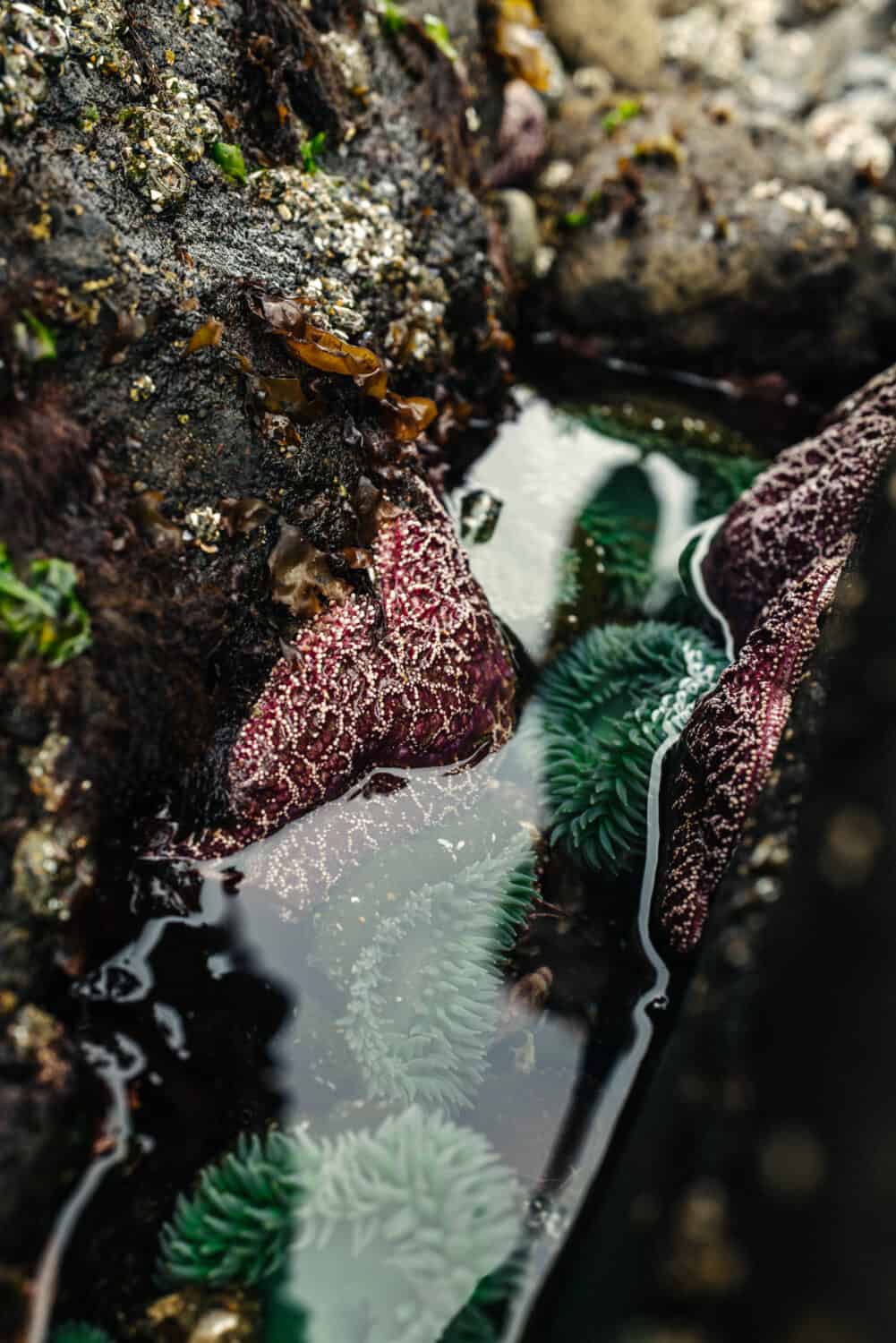
21. The Park is known for its tide pools.
Just like Oregon tide pools, you’ll find sea urchins, sea stars, anemones, barnacles, limpets, mussels, snails, hermit crabs, shore crabs, sand crabs, Dungeness crab, sculpin, sand dollars, nudibranch, chiton, and sea slaters in Olympic National Park tide pools!
One of the coolest things about Olympic National Park tide pools is that park rangers often offer educational programs about the unique geological features that create the pools and what creatures live in them.
22. Olympic National Park is a popular whale watching spot.
Off of the Olympic Peninsula, you can catch sight of sperm whales, blue whales, finback whales!
Some of the best whale watching spots in the PNW include Kalaloch and South Beach (and campground), Port Townsend, Neah Bay, Shi Shi Beach, Rialto Beach, La Push Beaches, and Destruction Island Viewpoint.
Just over 2 hours to the east in Seattle, the Whale Trail is a conservation and trail project. It works with the NOAA Fisheries, National Marine Sanctuaries, and WA Dept of Fish and Wildlife to help protect the whales while also giving people opportunities to see them from the shore! Check out any of the sites here.
Read More: 27 Romantic Getaways in Washington
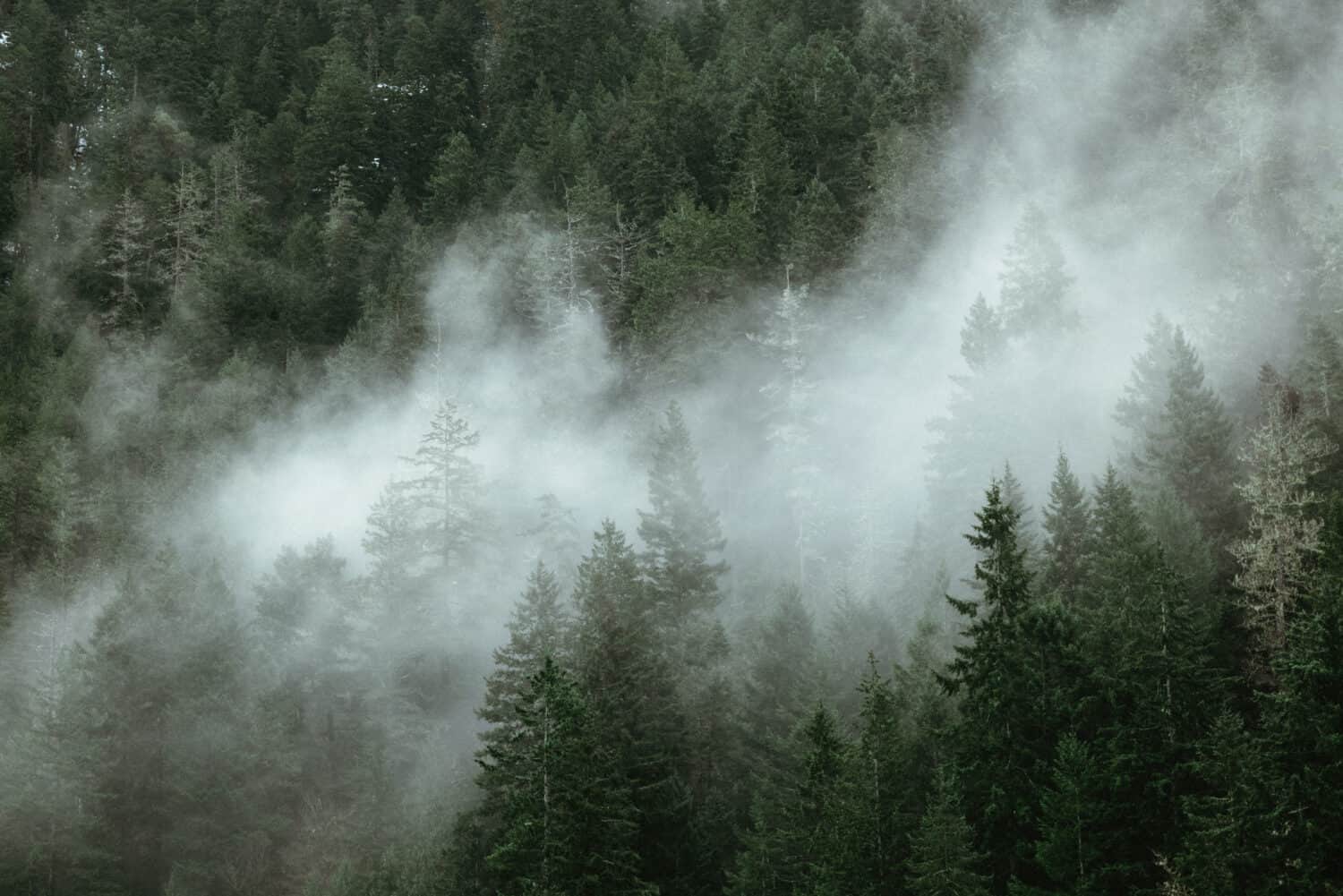
23. There have been movies filmed in Olympic National Park.
Among the many movies set in the PNW, Fantastic Fungi, The Legend of Black Thunder Mountain, and Septaria have all been filmed in Olympic National Park, to name a few.
The nearby Forks, Washington was even the inspiration for the popular vampire saga, Twilight!
What are some of other fun facts about Olympic National Park that you know?? Share them in the comments!
More Olympic National Park Resources
The Complete Olympic National Park Photography Guide (Made by Locals!)
46 Essential Olympic National Park Packing List Items
30 Epic Things To Do In Olympic National Park
The Complete Olympic Peninsula Road Trip Route (15+ Incredible Stops!)
The Best Places To Live In The Pacific Northwest
17 Chill and Easy Activities For Seniors in Washington
25 Incredible Washington Winter Activities
